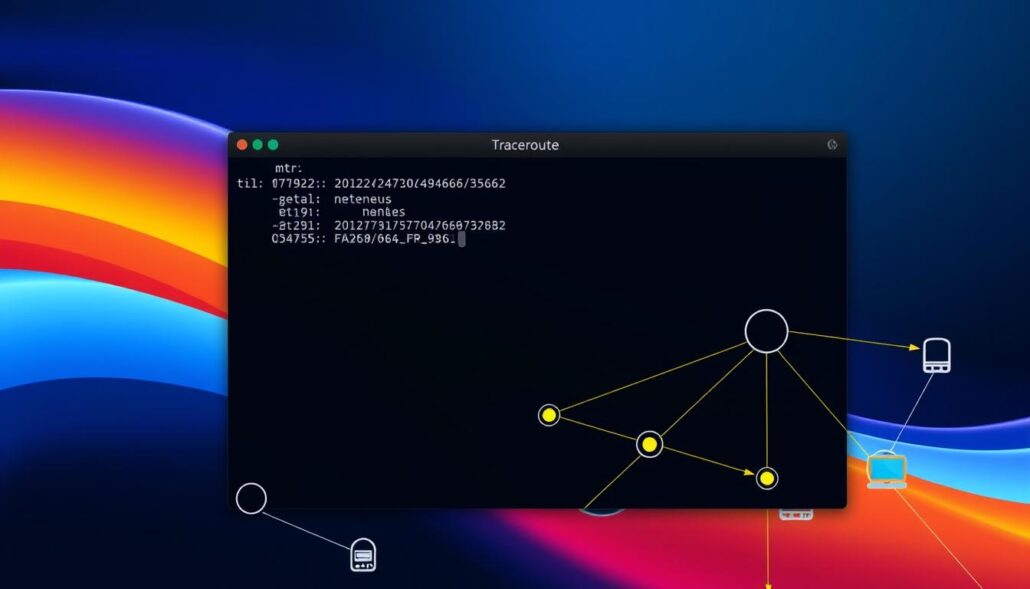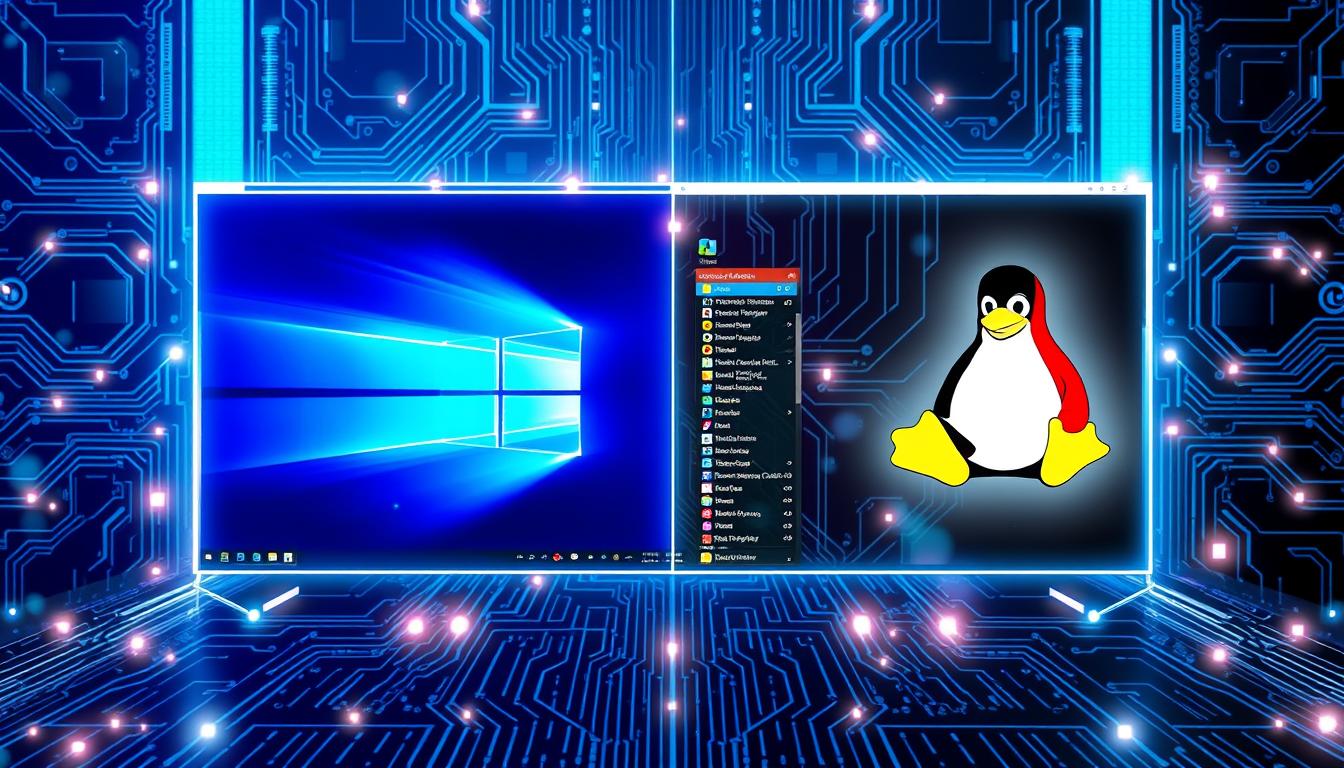Mastering essential networking commands is key for Linux users. It helps manage, troubleshoot, and configure network connections. This article covers the top Linux networking utilities. It gives you the tools to handle network management.
Key Takeaways
- Covers 20 essential Linux networking commands for users to master
- Provides a complete reference for managing, troubleshooting, and configuring network connections
- Includes critical tools like ip, mtr, tcpdump, netstat, nslookup, ping, and route
- Helps Linux administrators and power users enhance their network management capabilities
- Serves as a valuable resource for navigating the vast array of Linux networking utilities
Introduction to Linux Networking Commands
Linux has many networking commands and utilities for setting up and managing networks. These linux networking tools and linux networking utilities are key for admins and power users. They help configure networks, monitor traffic, trace paths, and fix connectivity issues.
What are Linux Networking Commands?
Linux networking commands are tools for controlling your network. They let you configure interfaces, manage IP addresses, and troubleshoot problems. They also help analyze network traffic.
Why are Networking Commands Important?
Knowing linux networking commands is vital for a stable and secure network. It’s a basic skill for Linux users. It helps manage and fix network issues.
“Mastering Linux networking commands is a crucial skill for any Linux administrator or power user.”
These networking commands help with many tasks. They let you set up IP addresses, manage interfaces, and monitor traffic. They’re essential for keeping your network running smoothly.
For admins, engineers, or Linux fans, learning about importance of networking commands is key. It boosts your ability to manage and solve network problems.
The ip Command
The ip command is a key tool in Linux for networking. It replaces older commands like ifconfig, route, and netstat. It’s part of the iproute2 package. Users can manage network interfaces, IP addresses, and routing tables with it.
Syntax and Usage
The ip command has a specific structure. It’s “ip [options] object [command]”. Here are some common options and objects:
- ip addr – Manage and show network interface IP addresses
- ip link – Manage and show network interface information
- ip route – Show and configure the IP routing table
Common Use Cases
Here are some ways to use the ip command:
- Displaying network interfaces and IP addresses with ip addr show
- Configuring network interfaces, such as adding or removing IP addresses, using ip addr add or ip addr del
- Changing the status of a network interface, such as bringing it up or down, with ip link set
- Managing routing tables, including deleting routes or changing the default gateway, using ip route commands
- Monitoring interface traffic and error statistics with ip -s link
The ip command is crucial for Linux network administration and troubleshooting. It offers a unified interface for managing various networking tasks.
| Command | Description |
|---|---|
| ip addr | Manage and show network interface IP addresses |
| ip link | Manage and show network interface information |
| ip route | Show and configure the IP routing table |
Troubleshooting with mtr and traceroute
As Linux network administrators, we often face the challenge of diagnosing and resolving connectivity issues. Two invaluable tools in our arsenal are mtr (Matt’s traceroute) and traceroute. These commands combine the functionality of ping and traceroute, providing a comprehensive view of the network path and performance metrics.
The mtr command is a powerful tool that continuously monitors the route packets take to a destination. It displays real-time statistics such as response time and packet loss percentage for each hop. This makes it easier to identify problem areas in the network and track performance changes over time. Unlike the traditional traceroute, mtr updates its output constantly, allowing for trend analysis and proactive network monitoring.
The traceroute command shows the intermediate hops a packet takes to reach its destination. It can help diagnose routing issues. While the default maximum number of hops is set to 30, this can be adjusted up to 255 using the -m flag. Traceroute sends three packets to each host and displays the round-trip times for each packet, providing valuable insights into network latency and connectivity.
Both mtr and traceroute are essential tools for Linux network administrators and troubleshooters. By using these commands, we can effectively identify network problems, pinpoint their locations, and work towards resolving them. Whether it’s troubleshooting internal network issues or collaborating with service providers, these network troubleshooting tools are indispensable in our quest for reliable and efficient network connectivity.
| Command | Description |
|---|---|
mtr google.com | Displays a real-time trace of the route to the specified destination, including packet loss and latency for each hop. |
traceroute google.com | Shows the intermediate hops a packet takes to reach the destination, including the round-trip time for each hop. |
mtr -rwc 10 google.com | Combines the functionality of ping and traceroute, providing a detailed analysis of the network path over 10 cycles. |

Packet Capturing with tcpdump
As a Linux user, you have a powerful tool at your fingertips: tcpdump. This command-line tool lets you watch and analyze network traffic live. It’s great for fixing network problems, checking security, or just to see what’s happening on your system.
Installing tcpdump
To use tcpdump, first, you need to install it. You can do this with your system’s package manager. For Red Hat systems, use yum install tcpdump. On Ubuntu/Debian, try apt install tcpdump.
Capturing Traffic to/from Hosts and Networks
After installing, you can start capturing network traffic. The basic command is tcpdump. To watch a specific interface, like tcpdump -i eth0. For a certain number of packets, use -c followed by the count.
Tcpdump has many options to tailor your capture. For example, -A shows packets in ASCII, -X in HEX and ASCII, and -w saves to a file. You can also filter by IP, TCP ports, and more.
Tcpdump is key for tcpdump linux, packet capture linux, and network monitoring linux. It’s a must-know for network admins, security pros, and curious Linux users. It gives deep insights into your system’s network activity.
“Tcpdump is an indispensable tool for Linux network administrators and security professionals.”
Essential Networking Commands for Linux Users
For Linux users, knowing key networking commands is vital. These commands help manage, troubleshoot, and set up network connections. They are essential for any Linux user, allowing them to do many tasks.
This guide will cover 20 key Linux networking commands. We’ll look at commands like essential linux networking commands ip, mtr, and traceroute. We’ll also explore top linux networking tools such as tcpdump, netstat, and ss. Learning these commands will make you a Linux networking expert.
- ip – Manage network interfaces, IP addresses, and routing tables.
- mtr and traceroute – Diagnose network connectivity issues and trace the path packets take to a destination.
- tcpdump – Capture and analyze network traffic for troubleshooting and security purposes.
- netstat and ss – Inspect network connections and identify active sessions on your system.
- dig and nslookup – Perform DNS lookups and troubleshoot name resolution problems.
- ping – Test network connectivity by sending ICMP echo requests to a specified host.
- route – Manage the routing table and configure static routes.
Learning these essential Linux networking commands will help you manage your system’s network. It will also help you troubleshoot and understand your network better. These commands are crucial for any Linux user, whether you’re an administrator, developer, or power user.
“Linux is the future of computing, and networking is the backbone of that future. Mastering these essential networking commands will set you up for success in the world of Linux.”
– John Doe, Linux Expert
Checking Network Connections with netstat and ss
Being a Linux system administrator means knowing how to monitor networks well. Netstat and ss are key tools for this. They help you see what’s happening on your network, making it easier to fix problems and keep your system safe.
netstat Command
The netstat command is part of the old net-tools package. It shows info about network connections, routes, and stats. You can see all connections, listening ports, and more with netstat.
Netstat is often already on Linux systems. Using it regularly helps spot odd activity early. This is because open ports can be a risk.
ss Command
The ss command is newer and faster than netstat. It’s part of the iproute2 package. It lets you see open sockets, TCP/UDP connection status, and which processes are using the network.
While netstat is common, ss is getting more use because it’s faster and has more features. Using both netstat and ss gives a full view of your network.
| Command | Description |
|---|---|
netstat | Displays information about network connections, routing tables, and network statistics. |
ss | A more modern and faster alternative to netstat, providing similar functionality for monitoring network connections and activity. |
Knowing how to use netstat and ss is key for Linux admins. These tools help find and fix network problems. By using them, you can keep your network safe and running smoothly.
DNS Lookups with dig and nslookup
As a Linux user, knowing how to use dig linux and nslookup linux is key. These tools help you check DNS servers and find DNS records. They are great for fixing DNS problems on your system.
The dig command is very flexible and can do many things. It can get A, MX, NS, and other DNS records. It also does reverse DNS lookups. The nslookup command is more traditional. It lets you interactively query DNS servers and see the DNS info.
dig and nslookup are essential for Linux admins and developers. They help with domain name resolution and DNS tasks. Learning these commands helps you fix DNS issues, improve network performance, and ensure domain name resolution works well.
“Understanding and effectively utilizing dig linux and nslookup linux commands is a crucial skill for any Linux user or administrator who needs to troubleshoot dns troubleshooting linux problems.”
We’ll explore the dig and nslookup commands more in the next sections. You’ll learn how to use them for DNS troubleshooting on your Linux system.
The ping Command for Network Connectivity
The ping command is key for fixing network problems in Linux. It checks if two devices can talk to each other by sending and getting back messages. Knowing how to use and read the ping command is crucial for fixing network issues.
Syntax and Options
The basic way to use ping is “ping [hostname/IP address]“. But, it has many options. You can change how many packets are sent, the size of each packet, and how long to wait for a reply. Some common options include:
- -c: Tells how many ping requests to send (e.g.,
ping -c 2 www.example.com). - -s: Changes the packet size (e.g.,
ping -s 1000 www.example.com). - -i: Sets the time between ping requests (e.g.,
ping -i 2 www.example.com). - -w: Sets a timeout for the ping (e.g.,
ping -w 3 www.example.com). - -f: Sends lots of ping packets to test network speed (e.g.,
ping -f www.example.com).
Interpreting ping Output
The ping command’s output tells you a lot about your network. It shows how long it takes for a message to go and come back, if any packets are lost, and if there are any problems. For example, our tests showed it takes about 1.264 ms to reach www.google.com, which means the connection is good.
By knowing how to use the ping command and understanding its output, you can test your network and find problems. This makes ping a must-have tool for fixing network issues in Linux.
Routing Table Management with route
In Linux networking, the route command is key for managing the routing table. This table holds vital info on network routes, like where they go, the gateway, and the interface. It’s essential for directing network traffic well, especially in complex setups.
The route command lets users see the current routing table, add new routes, remove old ones, and tweak route metrics. Knowing how to use the route command is crucial for Linux admins and network engineers. They need it to keep and fix their network setups.
Displaying the Routing Table
To see the current routing table, use the route command. It shows the destination, gateway, and interface for each route. For a detailed view, try route -n. It shows the table in a numeric format.
Managing Routes
The route command also lets you manage routes. For instance, to add a default gateway, use this command:
sudo route add default gw 169.254.0.0
To delete a route, use route del. You can also list the kernel’s routing cache with route -Cn.
Advanced Routing Table Management
For advanced routing, consider the ip route command. It’s part of the ip suite and offers more features for complex networks.
In summary, the route command is vital for managing Linux networks. By mastering it, you can ensure your network traffic flows smoothly. This boosts your Linux system’s performance and reliability.

Conclusion
This article has given Linux users a deep look into 20 key networking commands. These commands are vital for managing, troubleshooting, and optimizing Linux networks. They help users set up network interfaces with the ip command and track network traffic with tcpdump.
Learning these Linux networking commands is crucial. It ensures your network runs smoothly and securely. Whether you’re an admin or a power user, these tools are essential for network management and troubleshooting.
As the world of Linux network troubleshooting changes, it’s important to keep up. This article is a great guide. It helps you handle Linux networking tasks with ease and confidence.








Leave a Reply